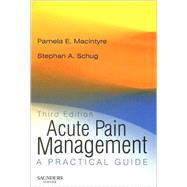
| Introduction | |
| Effectiveness of acute pain management | |
| Adverse effects of undertreated severe acute pain | |
| Acute pain management and patient outcomes | |
| Organizational Considerations: Education Standardization | |
| Acute pain services | |
| Assessment of the Patient With Acute Pain: Assessment of pain and pain relief | |
| Assessment of adverse effects | |
| Pharmacology of Opioids: Mechanisms of action | |
| Effects of opioids | |
| Predictors of opioid dose | |
| Titration of opioid dose | |
| Commonly used opioid agonists | |
| Partial agonists and agonist-antagonists | |
| Opioid antagonists | |
| Pharmacology of Local Anesthetic Drugs: Mechanism of action | |
| Efficacy of local anesthetic drugs | |
| Adverse effects of local anesthetic drugs | |
| Commonly used local anesthetic drugs | |
| Non-Opioid and Adjuvant Analgesic Agents: Paracetamol (acetaminophen) | |
| Non-selective non-steroidal anti-inflammatory drugs | |
| Selective COX-2 inhibitors | |
| Nitrous oxide | |
| NMDA receptor antagonist drugs | |
| a2-Adrenergic agonist drugs | |
| Calcitonin | |
| Antidepressant drugs | |
| Anticonvulsant drugs | |
| Membrane-stabilizing drugs | |
| Routes of Systemic Opioid Administration: Oral route | |
| Intramuscular and subcutaneous routes | |
| Intravenous route | |
| Rectal route | |
| Transdermal route | |
| Transmucosal routes | |
| Patient-Controlled Analgesia: Equipment Analgesic and other drugs used with PCA | |
| The PCA 'prescription' | |
| Requirements for the safe management of PCA | |
| Management of inadequate analgesia | |
| 'Step-down' analgesia | |
| Complications of PCA | |
| Alternative systemic routes of PCA administration | |
| Epirural and Intrathecal Analgesia: Anatomy | |
| Contraindications | |
| Drugs used for epidural analgesia | |
| Requirements for the safe management of epidural analgesia | |
| Patient-controlled epidural analgesia | |
| Management of inadequate analgesia | |
| 'Step-down' analgesia | |
| Complications and side effects of epidural analgesia | |
| Concurrent anticoagulant or antiplatelet medications | |
| Intrathecal analgesia | |
| Other Regional and Local Analgesia: Continuous peripheral nerve blockade | |
| Intra-articular analgesia | |
| Wound infiltration | |
| Topical analgesia | |
| Non-Pharmacological Therapies: Psychological interventions | |
| Transcutaneous electrical nerve stimulation | |
| Acupuncture | |
| Physical interventions | |
| Acute Neuropathic and Persistent Postacute Pain: Pathophysiology of neuropathic pain | |
| Clinical features of neuropathic pain | |
| Acute neuropathic pain syndromes | |
| Treatment of acute neuropathic pain | |
| Progression of acute to persistent pain | |
| Preventive analgesia | |
| Non-Surgical Acute Pain: Burns injury | |
| Spinal cord injury | |
| Specific medical conditions | |
| More Complex Patients: Elderly patients | |
| Opioid-tolerant patients | |
| Patients with a substance abuse disorder | |
| Patients with obstructive sleep apnea | |
| Pregnant or lactating patients | |
| Patients with renal or hepatic impairment | |
| Self-Assessment Questions | |
| Index | |
| Table of Contents provided by Publisher. All Rights Reserved. |
The New copy of this book will include any supplemental materials advertised. Please check the title of the book to determine if it should include any access cards, study guides, lab manuals, CDs, etc.
The Used, Rental and eBook copies of this book are not guaranteed to include any supplemental materials. Typically, only the book itself is included. This is true even if the title states it includes any access cards, study guides, lab manuals, CDs, etc.